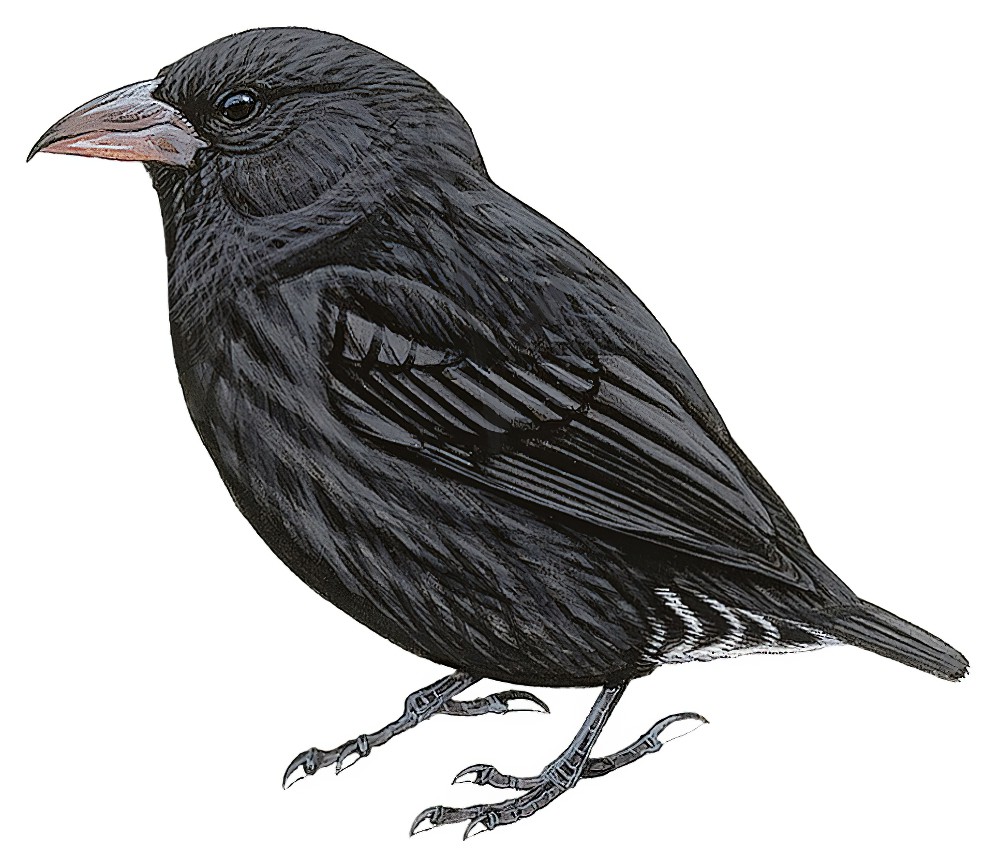Vampire Ground-Finch / Geospiza septentrionalis

Vampire Ground-Finch
SCI Name:
Protonym: Geospiza scandens septentrionalis Novit.Zool. 6 (2) p. 165
Taxonomy: Passeriformes / Thraupidae / Geospiza
Taxonomy Code: shbgrf1
Type Locality: Wenman, Galapagos b° Islands.
Author: Rothschild & Hartert
Publish Year: 1899
IUCN Status: Vulnerable
DEFINITIONS
GEOSPIZA
(Thraupidae; † Large Ground-finch G. magnirostris) Gr. γεω- geō- ground-, earth- < γη gē earth; σπιζα spiza finch < σπιζω spizō to chirp; "Mr. Gould exhibited from Mr. Darwin's collection of Birds, a series of Ground Finches, so peculiar in form that he was induced to regard them as constituting an entirely new group, containing 14 species, and appearing to be strictly confined to the Galapagos Islands. Mr. Gould believed the whole of these Birds to be undescribed, and remarked that their principal peculiarity consisted in the bill presenting several distinct modifications of form, while the general contour of the species closely assimilated. He proposed to characterize them under the separate generic appellations of Geospiza, Camarhynchus, Cactornis, and Certhidea. GEOSPIZA. Corporis figura brevissima et robusta. Rostrum magnum, robustum, validum, altitudine longitudinem præstante; culmine arcuato et capitis verticem superante, apive sine denticulo, lateribus tumidis. Naribus basalibus et semitectis plumis frontalibus. Mandibula superiori tomiis medium versus sinum exhibentibus, ad mandibulæ inferioris processum recipiendum. Mandibula inferior ad basin lata, hoc infra oculos tendente. Alæ mediocres remige primo paulo breviore secundo, hoc longissimo. Cauda brevissima et æqualis. Tarsi magni et validi, digito postico, cum ungue robusto et digito intermedio breviore; digitis externis inter se æqualibus at digito postico brevioribus. Color in maribus niger, in fœm. fuscus. GEOSPIZA MAGNIROSTRIS. (Spec. typ.)" (Gould 1837); "Geospiza Gould, Proc. Zool. Soc. Lond., 5, p. 5, Oct. 3, 1837—type, by orig. desig., Geospiza magnirostris Gould." (Hellmayr, 1938, Cat. Birds Americas, Pt. XI, p. 130). McKay & Zink 2015, formulate that the ground-finches represent a classic example of Sisyphean evolution, being transient locally adapted ecomorphs trapped before the completion of the speciation process, and that only one species, Darwin's Ground-finch G. magnirostris, should be recognised. Sisyphean encapsulates the endless futility of a fruitless laborious task. In Gr. myth. King Sisyphus of Corinth was punished in the void of eternity by having to push a huge boulder repeatedly up a hill, only for it to roll back before attaining the summit.
Var. Geospitza.
Synon. Cactornis, Cactospiza, Camarhynchus.
• (Passeridae; syn. Montifringilla † White-winged Snowfinch M. nivalis) "Einige wenige größere, aber sonst ähnliche Arten mit längeren Flügeln nennt man Erdfinken, (Geospiza:) weil sie fast beständig auf der Erde leben, und sich bloß auf Steine und Felsen, aber selten oder nie auf Bäume und Sträucher setzen. ... Schneefink. (Fring. nivalis.)" (Gloger 1841); "Geospiza Gloger, 1841, Gemein. Hand- und Hilfsbuch Naturgesch., p. 254. Type, by monotypy, Fringilla nivalis Linnaeus, 1766." (JAJ 2021).
septentrionale / septentrionales / septentrionalis / septentrionalium
L. septemtrionalis northern < septemtrio north.
● Erroneous TL "Northern parts of America" (= Tonga Tabu); ex “Northern Shrike” of Latham 1781 (syn. Clytorhynchus vitiensis).
UPPERCASE: current genus
Uppercase first letter: generic synonym
● and ● See: generic homonyms
lowercase: species and subspecies
●: early names, variants, mispellings
‡: extinct
†: type species
Gr.: ancient Greek
L.: Latin
<: derived from
syn: synonym of
/: separates historical and modern geographic names
ex: based on
TL: type locality
OD: original diagnosis (genus) or original description (species)












